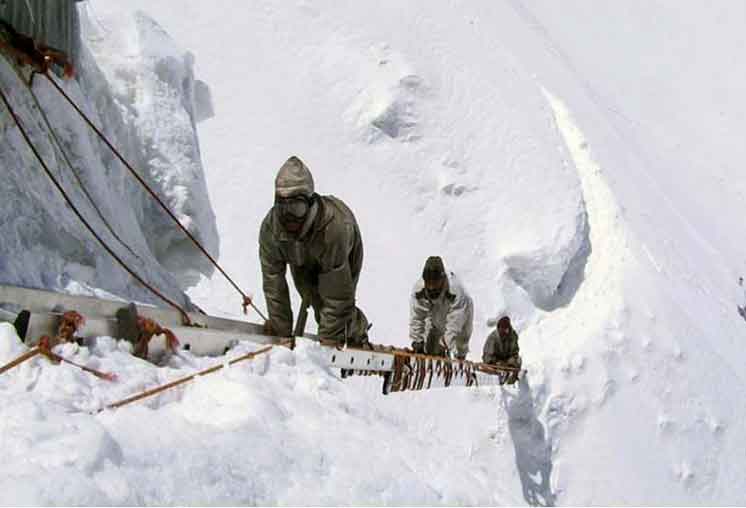IDR Blog
Siachen Standoff: A Cartographic, Colonial Legacy
On April 13, 1984, the Indian Army had launched ‘Operation Meghdoot’ and captured the inhospitable heights of the Siachen glacier, gradually bringing the whole glacial landmass under its control. Following this, several attempts were made by the Pakistan Army to dislodge the Indian Army from Siachen, all of which were successfully thwarted. Nevertheless, it was one of the toughest fights which the Indian armed forces had faced from Pakistan.
This glacial region which had shot to significance following ‘Meghdoot’, is also known as the world’s highest battlefield. The north of Siachen Glacier borders with Shaksgam Valley claimed by India but presently administered by China (and its west with Pakistan Occupied Kashmir), the region is also referred to as the world’s only nuclear trilateral junction. A ceasefire was finally agreed in 2003, but this has not ended the heavy militarization which characterizes this region.
Disputing over a climatically inhospitable area, the deaths of hundreds of Indian and Pakistani soldiers have come down heavy on the governments of both the nations, both literally in terms of numbers and at a social level too.
A recent disclosure by the Government of India puts the figure of soldier deaths in Siachen since ‘Meghdoot’ at 869 ever since the dispute has transitioned from being a flashpoint to one of ceasefire and surveillance.
Understanding that the standoff in this region has claimed more lives due to climatic freeze than for actual fighting, what explains the unending nature of this conflict? Most importantly, what is the rationale for a dispute over a no man’s land whose average altitude lies somewhere between 17000 and 21000 Feet, making human survival impossible?
The Ceasefire Line: The Karachi Agreement And Point NJ 9842
The conflict between India and Pakistan over Siachen can be traced back to the year 1947 when India got its independence and Pakistan was concomitantly formed. Located within what continues to remain a disputed territory, it was then the contention over the status of the princely state of Jammu and Kashmir, which got India and Pakistan at loggerheads with one another.
Speaking of its politics back then, Jammu and Kashmir was a Muslim majority territory ruled by a Hindu King, Maharaja Hari Singh. The Maharaja, owing to this complex situation, requested for a ‘Standstill Agreement’ rather than accede to either of the countries that the Maharaja was asked to choose between: the choice between India and Pakistan.
In the meanwhile however, Pakistan launched an offensive to occupy the Kashmiri territory following which the Maharaja appealed to India for assistance and signed the Instrument of Accession with it in 1948. The Indian army was immediately dispatched to defend Kashmir from being completely occupied.
The then Prime Minister Jawaharlal Nehru took this act of aggression to the United Nations, which through its resolutions appealed for a ceasefire. The Karachi agreement (1949) which was subsequently signed by India and Pakistan, demarcating the Ceasefire Line through the territory of Jammu and Kashmir, set the stage for the conflict.
The agreement demarcated the line as a temporary border in Kashmir up to a point named Point NJ 9842. Beyond NJ 9842, the agreement stated that the border will run ‘thence north to the glaciers’. While Pakistan interprets ‘thence north’ as a northeastern extension of border from NJ 9842 to the Karakoram Pass, India interprets it as a northwestern extension along the Saltoro Ridge towards the Indra Col (head of Siachen glacier). It is precisely near the Indra Col, where India’s border touches Pakistani and Chinese territory that makes Siachen a coveted region.
Even the Simla agreement, signed between India and Pakistan in 1972 after the 1971 Indo-Pak war, left this ambiguity of borders beyond NJ 9842 untouched. The Ceasefire Line was renamed as the Line of Control (LoC), but its terminal point remained NJ 9842 only.
In the 1970s, the Pakistani army promoted foreign mountaineering expeditions to legitimize its claim on Siachen. The official maps in US and Europe also began to show Siachen glacier lying in the Pakistani territory. A discovery of a similar map by an Indian Army officer, Colonel Narinder ‘Bull’ Kumar alarmed the forces and in late 1970s he sought permission to carry out expeditions to the glacier and the Indian army increased its presence through several follow up expeditions and aerial patrols. Finally, Operation Meghdoot was executed and troops were helilanded to the strategic passes, Bilafond La and Sia La located on the Saltoro ridge, to the west of Siachen.
Siachen Dispute: A Legacy of Colonial Cartography
The mapping of India’s northwest frontiers was carried out in the heydays of the Great Game, a 19th century scramble between Russia and the British Empire over the unexplored terrain of Central Asia and the areas adjoining it. Historically, all the invasions of the Indian subcontinent took place through its northwest frontiers. The threat of an expansionist Russia alarmed the British of a possible invasion from the Khyber Pass in the Hindukush Mountains or the Bolan Pass (Balochistan). This resulted in the drawing of Durand Line (present day Pakistan-Afghanistan border), which ran from Balochistan in the South, to the Wakhan region in the north, securing India’s northwest frontiers.
The threat resumed when the Russian invasion of Central Asian Khanates brought the Russians to the Pamir Mountains (present day Afghan-Tajikistan border). Added to this, Russia’s commercial ties with Xinjiang posed a threat of an invasion from the north. Therefore, the mapping of the Karakoram mountains was carried out to secure India’s northernmost frontiers.
By late 19th century, the British administration had mapped almost the whole Himalayan region. In Kashmir, the strategic passes of Gilgit, Ladakh and Baltistan were also mapped. However, Siachen glacier was still unexplored and had been vaguely mentioned by earlier explorers. Neither its length, nor its slope direction was known. Even the legendary imperial explorer Sir Francis Younghusband gave it a miss while exploring the high Karakorams in 1889.
It was Tom George Longstaff, an officer in the British Indian Army who gave a precise account of Siachen’s topography in 1909. He discovered that Siachen glacier gives rise to the Nubra river which later merges with the Shyok River and finally the Indus river, making the glacier a part of the Indus river basin. To the north of Indra Col (Siachen Glacier’s head) is the Urdok Glacier which flows into the Shaksgam river (which merges into the Yarkand river), making it a part of the Tarim basin in the Chinese territory. However, in view of the ‘Great Game’ when Chinese Qing Dynasty weakened, Britain revised its boundary to to the north of the Shaksgam Valley. In 1897 a Memorandum indicating this line running was indicated by Sir John Ardagh.
In 1911, an American mountaineer couple (Fanny Workman and William Workman) spent two months at the glacier mapping it thoroughly and naming several mountain peaks surrounding the glacier. The head of Siachen was named by the Workmans as ‘Indra Col’.
In this way, Siachen was cartographically represented as lying on the Indian side where as the Urdok glacier to its north became a part of the Chinese territory. Later, the region to the north of Siachen was acceded by Pakistan to China under the 1963 boundary agreement as ‘Trans-Karakoram Tract’, hence bringing the Chinese to the north of Siachen.
In the larger picture, India not only inherited the borders demarcated out of colonial calculations, but also the colonial fears which led to such mapping. The presence of a hostile Pakistan and a wily China has reproduced the same fear of a collusive thrust from the northwest and Northeast; one which had bothered the British during the era of Great Game.
The fear which had prompted British to secure India’s northwest frontiers through the Durand Line and later the northern borders of Kashmir (Karakoram Rrange) has transcended into the present, post-colonial times with the Indo-Pak conflict, courtesy the cartographic ambiguity surrounding the status of the area beyond NJ 9842. Even as hundreds of soldiers have laid their lives and millions of dollars have been spent to maintain the armies at such altitude, Siachen still remains a bone of contention between India and Pakistan.
Courtesy: http://southasiamonitor.org/detail.php?type=n&nid=15053






